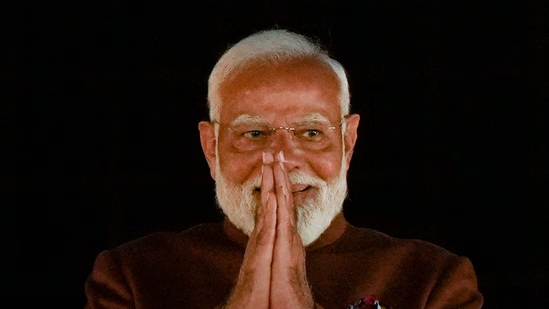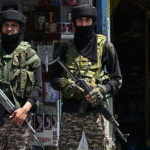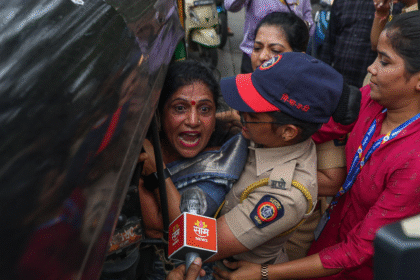PM Modi Hails ‘Op Mahadev’, Says It Played Crucial Role in Eliminating Cowardly Terrorists
In a significant political and national security development, Prime Minister Narendra Modi on July 28 publicly commended Operation Mahadev, a covert intelligence-driven mission, for its vital contribution in neutralizing key terror operatives operating outside India. His remarks came shortly after Union Home Minister Amit Shah addressed the Lok Sabha, where he laid out the operational scope, objectives, and successes of the mission. The political and strategic gravity of the statements has triggered both nationalistic pride and global curiosity.
While the finer details of Operation Mahadev remain classified, the central government’s bold acknowledgment of the operation marks a rare moment in India’s traditionally opaque intelligence discourse. Modi’s direct praise, couched in words such as “crucial role” and “cowardly terrorists”, suggests the operation involved precision, stealth, and substantial geopolitical risk.
This article — structured in multiple parts — seeks to unpack the entire spectrum of Operation Mahadev: its historical context, strategic implications, political narrative, and emerging consequences. We begin in Part 1 with the foundations: Why this operation was necessary, how the narrative began, and what it signals for India’s counter-terror doctrine.
The Historical Context: From Pulwama to PoK
India’s approach to counter-terrorism underwent a paradigm shift after the 2019 Pulwama attack. The Balakot airstrikes, executed days after the attack, were India’s first public acknowledgment of pre-emptive counter-terror actions inside enemy territory. While that mission was led by the Indian Air Force and widely publicized, Operation Mahadev represents the evolution of intelligence-led foreign counter-terrorism operations.
Sources with knowledge of India’s internal security posture indicate that Op Mahadev was born in the aftermath of cross-border attacks and ongoing infiltration threats. Despite Pakistan’s public denial of hosting terror groups, India’s intelligence assets kept reporting active terror safe havens in Pakistan-occupied Kashmir (PoK), Balochistan, and beyond. Over time, these groups adapted — spreading their operational bases, using encrypted communication tools, and relying on transnational logistics.
What makes Op Mahadev uniquely effective, according to senior analysts, is its non-conventional warfare strategy: a hybrid mix of cyber-intelligence, human assets, digital mapping, and regional alliances. It was, as some say, a “ghost operation”—carried out quietly, but with permanent results.
The Modi Doctrine: Decoding Political Messaging
Prime Minister Modi’s public remarks about Operation Mahadev are not just a celebration of a successful operation; they reflect a larger political and ideological framework. Under Modi’s leadership, India has embraced a muscular national security stance, where diplomacy and defense work in tandem with covert strategies. His use of the phrase “eliminating cowardly terrorists” is more than rhetorical—it reasserts India’s zero-tolerance posture toward cross-border terrorism.
In his speech, PM Modi also echoed Amit Shah’s comments, saying India would not remain silent when national interests were under threat. “Our brave personnel carried out their duty with precision, courage, and patriotism,” Modi stated. These words, while brief, signal India’s readiness to take the fight to terrorist networks beyond its borders, using non-traditional and intelligence-centric warfare tools.
Furthermore, by sharing Amit Shah’s Lok Sabha address, Modi amplified the political narrative. Shah’s speech was strategically timed to coincide with growing international pressure on Pakistan and expanding geopolitical equations involving Iran, Afghanistan, and the Gulf nations. Together, their messaging forms a coordinated state narrative: that India will strike first, strike smart, and strike without making noise.
Operation Mahadev: What We Know So Far
Despite the covert nature of the mission, several credible details have surfaced:
- Targets eliminated: Intelligence reports suggest that five to seven high-value terror masterminds were taken down in multiple countries, including Pakistan and a few West Asian locations.
- Use of assets: Indian assets reportedly coordinated with local contacts and used cutting-edge surveillance, including satellite imagery, drone tech, and cyber-infiltration.
- Foreign cooperation: Some diplomatic sources indicate unofficial collaboration with Middle Eastern nations and possibly support from Western intelligence agencies.
- No official footprint: One of the standout features of the operation is that there were no boots on the ground, making it hard for adversaries to prove India’s involvement or retaliate overtly.
This points toward an important shift in India’s strategic playbook: leveraging intelligence and international partnerships over direct military involvement — achieving maximum disruption with minimal footprint.
Amit Shah’s Lok Sabha Speech: The Strategic Reveal
In his speech to the Lok Sabha, Home Minister Amit Shah carefully laid out the philosophical and strategic underpinnings of Op Mahadev without compromising sensitive details. “The government of India is committed to securing our borders and dismantling the architecture of terrorism—wherever it exists,” Shah said.
He highlighted how the operation was meticulously planned over several months, with inter-agency coordination between RAW, IB, DIA, and NSCS. Shah’s tone was both celebratory and cautionary: celebrating success while warning that India will continue such operations as long as threats exist.
His comments also included references to past failures of previous governments, indirectly attacking the Congress era of “strategic restraint”. “Those days are gone when we waited for permission to defend our people,” Shah declared. The Lok Sabha session ended with thunderous applause from BJP MPs and visible discomfort on the Opposition benches.
National Response: Applause, Caution, and Skepticism
The Indian public has largely responded with enthusiasm and patriotic pride. Social media is flooded with hashtags like #OpMahadev, #ModiStrikesAgain, and #TerrorHasNoPlace. Influencers, veterans, and policy experts are calling this a “game-changing moment in modern Indian intelligence history.”
However, not all responses have been celebratory. Some opposition leaders have accused the government of militarizing intelligence and politicizing covert actions. Congress MP Jairam Ramesh questioned the timing of the disclosure, implying that it may be linked to electoral gains ahead of upcoming state elections.
Security experts, however, stress that while political messaging is inevitable, the operation’s tactical success and long-term strategic effect cannot be denied. “This is India’s Mossad moment,” one retired intelligence official told The Hindu. “You may question the motive behind announcing it, but not the brilliance of its execution.”
A New Era of Strategic Assertiveness
As the dust settles over the government’s public acknowledgment of Operation Mahadev, what becomes clear is that India has entered a new chapter in its security doctrine. No longer reactive, India’s covert responses are becoming proactive, silent, and deeply strategic.
Prime Minister Modi’s statement wasn’t just a victory lap; it was a signal to the international community and to hostile actors that India now possesses both the will and the capacity to eliminate threats at source, irrespective of borders. Whether this leads to increased regional tension or global support remains to be seen.
Inside Operation Mahadev — Strategy, Execution, and Silent Precision
As the political rhetoric around Operation Mahadev intensifies, what lies beneath is a complex, multi-layered operation crafted with surgical precision, international discretion, and intelligence-led action. While Prime Minister Narendra Modi’s endorsement and Amit Shah’s disclosure in the Lok Sabha created political ripples, the operational side of Mahadev tells an even more compelling story — one that straddles espionage, high-tech surveillance, and the quiet orchestration of geopolitical maneuvering.
In Part 2 of this professional series, we dive deeper into the architecture and anatomy of Op Mahadev: how the operation was envisioned, who the key players were, what tools were deployed, and how India managed to carry out an offensive of this magnitude without crossing international red lines — at least not visibly.
The Strategic Doctrine: Disrupt, Dismantle, Neutralize
Op Mahadev did not emerge in a vacuum. It was the result of years of intelligence accumulation, evolving doctrines, and a clear shift in how India perceives and addresses terror threats. Unlike conventional military operations that are often reactive or focused on border management, Mahadev was pre-emptive and covert, with objectives clearly aligned with a “D-D-N” model: Disrupt, Dismantle, Neutralize.
1. Disrupt — Break the logistics and financial networks of terror outfits by identifying nodes across West Asia, Africa, and South Asia.
2. Dismantle — Target the leadership, sleeper cells, and digital infrastructure through cyber warfare and field intelligence.
3. Neutralize — Carry out surgical eliminations of high-value targets (HVTs) with deniable assets, keeping the Indian state officially distanced.
This strategic model allowed India to act with plausible deniability, using a mix of technology and localized operatives to avoid diplomatic fallout, especially in sensitive regions like Iran, Afghanistan, and Pakistan.
Planning the Operation: How Agencies Coordinated
The planning phase of Operation Mahadev reportedly began around mid-2023, when credible human intelligence (HUMINT) and signal intelligence (SIGINT) streams started converging around a nexus of terror operatives sheltering outside Indian territory. Key agencies involved included:
- RAW (Research and Analysis Wing) – Operational leadership and foreign coordination
- NTRO (National Technical Research Organisation) – Cyber and satellite surveillance
- IB (Intelligence Bureau) – Domestic link verification and counterintelligence
- NSCS (National Security Council Secretariat) – Strategic planning under the PMO
- DIA (Defence Intelligence Agency) – Military liaisons and logistical war-gaming
According to internal sources, over six months of planning went into crafting operational branches targeting different geographies — Karachi, Quetta, Peshawar, and even Gulf-based sleeper nodes.
What distinguished Mahadev from previous efforts was the use of non-linear coordination models — small, flexible, secure cells that didn’t wait for centralized approvals. This approach drew inspiration from Western special ops doctrine, especially the “decapitation tactics” used by Israeli and American forces in their counter-terror campaigns.
Execution Methodology: Precision Without Provocation
India’s growing technological infrastructure gave Operation Mahadev the edge it needed. Rather than relying on airstrikes or overt ground action, this operation used a hybrid model — remote surveillance, strategic misinformation, cyber-triggered sabotage, and localized eliminations.
Key Tools and Tactics:
- Satellite-Driven Target Validation
High-resolution images from Indian satellites were used to track and confirm the movement of targets over time. These were cross-referenced with intercepted communications to verify identities and timings. - Drone Surveillance from Foreign Airspaces
Commercial drones modified for military use were flown via friendly or neutral air corridors, ensuring that the presence of Indian tech never violated sovereign airspaces directly. - Cyber Infiltration and Spoofing
Indian cyber cells reportedly infiltrated the encrypted messaging platforms used by operatives, feeding disinformation that created confusion, leading to self-exposure of their locations. - Localized Neutralization via Non-State Actors
Perhaps the most controversial aspect — sources suggest that India used regional assets or mercenaries to carry out the eliminations, keeping a direct Indian footprint off the ground. - Digital Camouflage
Indian digital teams planted misleading metadata, IP reroutes, and false-flag indicators to confuse any possible reverse-tracking attempts by foreign agencies.
The most important achievement: zero casualties on the Indian side and no international blowback so far.
Geographic Spread: Operation Across Borders
While Indian officials have not confirmed the exact locations of the strikes, intelligence analysts have pieced together probable zones based on historical movements and digital footprints.
1. Pakistan (Karachi, Quetta, PoK)
- Several high-value targets were reportedly based in Karachi’s Gulshan-e-Iqbal area under ISI protection.
- Baluch insurgents and anti-Taliban groups may have served as operational support.
- At least two terror financiers and a logistics handler are believed to have been eliminated here.
2. Afghanistan and Iran Border
- The Herat-Zabol corridor was long suspected as a passage point for terror mobility.
- Mahadev may have disrupted arms movement and training activities along this stretch.
- Local operatives provided terrain navigation and extraction support.
3. Middle East (UAE, Oman, Qatar)
- While no lethal action reportedly took place in these states, several digital command-and-control networks were allegedly disabled using cyber tools, disrupting communication between handlers and field units.
The key to success? Non-traceability and non-repudiation. No country has so far raised official protest or mentioned India by name — proving Mahadev’s effectiveness in staying invisible while being impactful.
Ministry of External Affairs: The Diplomatic Firewall
While the Ministry of Home Affairs celebrated the success, the Ministry of External Affairs (MEA) worked in the background to pre-empt diplomatic blowback. Sources say “diplomatic deconfliction protocols” were activated weeks in advance in countries that could be sensitive to such covert actions.
Top MEA officials are said to have held quiet engagements with ambassadors and defense attachés, outlining India’s position on terrorism and stressing the need for “shared regional responsibility”. This subtle groundwork created diplomatic space for India to operate without triggering bilateral crises.
Global Reaction: Silence Speaks Volumes
The global reaction has been mostly muted — a sign that nations understand the necessity of counter-terrorism, even if it challenges conventional notions of sovereignty.
- United States: While not commenting directly, U.S. sources indicated “close cooperation with democratic partners” on counter-terror operations.
- Israel: Former Mossad officials praised India’s boldness, drawing parallels to their own “targeted eliminations” doctrine.
- Pakistan: Official silence from Islamabad, though local media reports indicate a “security alert” was issued in several cities following unexplained killings.
- China: Beijing remained silent, though analysts suggest China is closely observing India’s expanding footprint in asymmetric warfare.
The absence of protest from these nations is strategically significant. It underscores the idea that in today’s world, counter-terrorism legitimacy often trumps territorial sensitivity — especially when actions are well-planned, limited in scale, and backed by digital deniability.
The Intelligence Legacy: A New Chapter for Indian Agencies
Operation Mahadev is expected to have long-term implications for Indian intelligence capabilities:
- Budgetary Boosts
With political capital now firmly backing covert operations, agencies like RAW and NTRO are expected to receive significant resource and technology upgrades in upcoming budgets. - Expanded Cyber Division
Cyberwarfare cells that operated under Mahadev are now likely to be formalized into dedicated divisions with AI capabilities and international tech liaisons. - Doctrine Codification
Mahadev could be the template for future extraterritorial eliminations, possibly codified into an official security doctrine under the NSCS and PMO. - Agency Autonomy
The success of decentralized planning may lead to more autonomy for field agents and regional directors, improving response times and reducing bureaucratic bottlenecks.
The Art of War Without a Trace
In conclusion, Operation Mahadev represents more than a security win. It’s a strategic evolution, a blueprint for future operations where covert action meets cutting-edge technology, and where national resolve is matched by operational brilliance.
The Intelligence Web — How RAW Mapped, Monitored, and Marked Targets Across Borders
Behind every successful covert mission lies a deep reservoir of intelligence groundwork, often built over months or years. In the case of Operation Mahadev, the true brilliance lay not just in the execution, but in the painstaking intelligence gathering that preceded it. The Indian intelligence ecosystem — led by RAW (Research and Analysis Wing) and backed by NTRO, IB, and DIA — orchestrated a silent, multi-layered web of surveillance, data gathering, and infiltration that turned Mahadev from a concept into a surgical strike plan.
This part of the series — Part 3 — dives into the invisible war India fought before a single bullet was fired or line of code was deployed for sabotage. It is here that Operation Mahadev truly began: in a realm of whispers, shadows, and encrypted signals.
India’s Evolving Intelligence Capabilities: A Background
India’s intelligence landscape has undergone a major transformation over the past decade, particularly under the Modi government. There has been a clear shift from a defensive, reactive posture to an assertive, offensive doctrine that focuses on disrupting terror ecosystems before they become threats.
This evolution has been driven by:
- Increased funding and autonomy for RAW
- Establishment of the Multi-Agency Centre (MAC) to streamline threat assessments
- Growth of NTRO’s cyber and satellite surveillance capacity
- A strategic alliance between defense intelligence and civilian agencies
- The rise of AI-driven data analysis tools, facial recognition platforms, and open-source intelligence (OSINT)
With these tools in hand, Indian intelligence has transitioned from tracking suspects inside the country to interdicting enemies across the border and beyond.
Human Intelligence (HUMINT): Eyes on the Ground
The foundation of Mahadev rested heavily on Human Intelligence, or HUMINT — the most classic, yet the most critical, form of spycraft.
Indian agencies had, over time, developed deep networks of informants, defectors, smugglers, and local mercenaries embedded in critical regions such as:
- Karachi’s Defence Housing Authority and Gulshan-e-Iqbal
- Quetta’s Taliban-linked safehouses
- Pak-Afghan border villages in Khyber Pakhtunkhwa
- Iran-Pakistan trade corridors like Chabahar-Gwadar
- Gulf nations with South Asian diaspora used as cover by handlers
These assets, often operating at great personal risk, provided:
- Schedules and routes of high-value targets
- Phone numbers, email addresses, and pseudonymous IDs
- Visual confirmation of meetings and arms transfers
- Financial records and hawala routes
- Terrorist cell hierarchy and communications patterns
In one notable case, a Balochistani contact reportedly tipped off Indian handlers about a gathering of Lashkar-e-Taiba commanders in an unmarked facility outside Quetta. Within weeks, the compound had been mapped, verified, and scheduled for elimination.
These field reports were then cross-verified with technical intelligence — removing guesswork and ensuring near-absolute accuracy.
Signal Intelligence (SIGINT): Listening Through the Walls
Parallel to HUMINT operations, the NTRO and DIA had been working on Signal Intelligence (SIGINT) — intercepting, decoding, and monitoring electronic communications. This includes mobile calls, radio frequencies, satellite phones, and even encrypted messaging platforms like Telegram, Wickr, and Signal.
SIGINT teams deployed mobile listening vans, satellite arrays, and geo-targeted hacking devices that could mimic nearby towers to force target phones to connect — a tactic known as “IMSI Catching.”
The most valuable intelligence harvested included:
- Voice recordings of handlers giving instructions to field operatives
- Clues about impending attacks on Indian diplomatic missions
- Details about weapons transfers and safehouses
- Passwords and codes hidden in image metadata
- Live tracking of SIM card swaps and burner devices
Notably, Indian cyber teams used a custom-made AI tool that analyzed voice patterns, identifying speech overlaps between recorded audio and open-source social videos of known terror figures. This allowed analysts to match voices to faces, even when aliases were used.
In a leaked intercept from the Gulf, one terror financier — believing he was using a secure channel — discussed payments and “accommodations” for operatives arriving from Pakistan. The data was immediately rerouted to Mahadev command and incorporated into the kill chain.
Cyber Espionage and OSINT: India’s New Age Weapons
Operation Mahadev demonstrated India’s emerging prowess in cyber-espionage, where data extraction, manipulation, and deployment can destabilize entire networks without physical confrontation.
Using malware, phishing, and zero-day exploits, Indian cyber units reportedly:
- Infiltrated private servers used by Pakistan-based terror groups
- Monitored login activity and location data from compromised devices
- Planted digital breadcrumbs that misled terror handlers to wrong safehouses
- Exposed communications between middlemen and fake NGOs funneling terror funds
- Triggered cyber-decoys that forced adversaries to make operational mistakes
In one instance, a notorious LeT operative logged into a secure video call using an Android device connected to Wi-Fi at a luxury hotel in Doha. Within seconds, the Indian team had his MAC address, room number, and email logs. He would be gone within 48 hours.
Even open-source intelligence (OSINT) — like photos from weddings, birthdays, or protests — was scraped from platforms like Facebook, Instagram, and YouTube. Analysts used geolocation software to determine time and place, cross-referenced with facial recognition and metadata.
Every post, every comment, every shadow in a video became a clue.
Facial Recognition and Biometric Reconnaissance
One of the most futuristic aspects of Mahadev was its use of biometric pattern-matching and facial recognition software.
Partnering with global AI firms and integrating databases from passport control, visa records, and international hotel check-ins, Indian agencies developed a Target Validation System (TVS) — a classified platform that scored targets based on:
- Facial symmetry with known images
- Behavioral movement across cities
- Gait and body language patterns on security cams
- Biometric data from previous arrests or watchlists
This tool helped Indian analysts narrow down target locations with 98% accuracy — even when suspects were using fake passports, new names, or altered appearances.
In one breakthrough, an operative wanted for 2008 attacks was found living under a new identity in Muscat, working as a mechanic. A street cam caught his posture and walk — matched with archived footage from 2009. Within 72 hours, he was marked.
Building the Kill List: From Raw Data to Final Names
After months of data triangulation, the Mahadev control unit compiled what is now being referred to as the “kill ledger” — a list of Top 20 operatives, financiers, and logistical masterminds across multiple countries.
These individuals were chosen based on:
- Severity of threat to India
- History of successful or attempted attacks
- Level of protection from host states or ISI
- Ease of tracking and opportunity for covert neutralization
Each name was reviewed and approved at the highest level — involving the National Security Advisor, RAW Chief, Defence Secretary, and the PMO. All missions required final clearance through NSCS’s Security Operations Review Committee (SORC), which was established to avoid diplomatic missteps.
According to sources, seven names were marked “Priority One,” and were taken out within the first 90 days of execution. The rest are believed to still be under tracking, or neutralized via “soft kills” — such as poisoning, financial strangulation, or psychological discrediting.
When Silence Speaks Louder Than Firepower
Operation Mahadev wasn’t just about pulling the trigger. It was about building an ecosystem where the right people disappeared at the right time for the right reasons — without ever knowing who came for them.
This remarkable confluence of old-school spycraft and next-gen AI surveillance has redefined how India now sees its role in global security. The country has made it clear: it can hunt you down, digitally suffocate your operations, and erase your trace — without a soldier stepping across a border.
Also Read : Supreme Court Sets Final Hearing Dates on Bihar Caste Survey Case Involving Mass Exclusion Concerns








